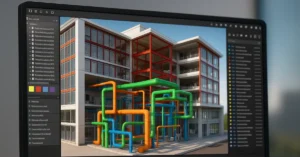
A Comprehensive Guide to Architectural Rendering
In the realm of architectural design, the ability to bring visions to life through rendering has become indispensable. Whether it’s crafting immersive interior spaces or capturing the grandeur of exterior structures, architectural rendering techniques and tools have evolved significantly in 2024 to meet the demands of designers, architects, and clients alike. This guide navigates through the latest advancements, offering insights into the diverse techniques and cutting-edge tools shaping the landscape of architectural visualization today.
Techniques:
Interior or Exterior CGI:
The dichotomy between interior and exterior CGI forms the cornerstone of architectural rendering. Interior renderings delve into the intricacies of indoor spaces, meticulously capturing the interplay of light, texture, and design elements to evoke a sense of ambiance and functionality. Conversely, exterior renderings transcend the boundaries of physical structures, portraying architectural forms against the backdrop of their contextual surroundings. Whether it’s the lush greenery enveloping a residential complex or the sleek contours of a futuristic skyscraper, exterior CGI serves as a canvas for visual storytelling, emphasizing scale, proportion, and spatial relationships.
By Type of Architectural Object:
Architectural rendering extends its reach across a myriad of sectors, each with its unique visualization requirements and design ethos. From the sleek lines of residential dwellings to the sprawling complexity of commercial complexes, rendering projects span the spectrum of architectural typologies. Whether it’s the industrial chic of a manufacturing facility or the timeless elegance of a public monument, each category presents its own set of challenges and opportunities for creative expression. By tailoring rendering techniques to suit the specific attributes and objectives of each architectural object, designers can breathe life into their concepts with unparalleled realism and precision.
Tools:
3D Modeling Software:
At the heart of architectural rendering lies the process of 3D modeling, where digital dreams take shape in virtual space. Tools such as SketchUp, AutoCAD, and Rhino empower designers to sculpt intricate geometries, manipulate spatial relationships, and visualize design concepts with unparalleled fidelity. From conceptual sketches to detailed blueprints, 3D modeling software serves as the foundation upon which architectural visions are realized, offering a versatile platform for experimentation and iteration.
Rendering Software:
Once the architectural model is crafted, it undergoes a transformative journey through rendering software, where polygons and vertices are imbued with life and vitality. Harnessing the power of rendering engines like V-Ray, Lumion, and Corona Renderer, designers can breathe realism into their creations, simulating lighting conditions, materials, and atmospheric effects with astonishing accuracy. Whether it’s the soft glow of sunlight filtering through a window or the dramatic interplay of shadows across a facade, rendering software enables architects to evoke emotive responses and convey the essence of their designs with unparalleled clarity.
Post-Production Software:
Beyond the realm of rendering, post-production software serves as a digital workshop where final touches are applied and artistic flourishes are imbued. Tools like Adobe Photoshop empower designers to fine-tune compositions, adjust color palettes, and enhance visual narratives with precision and flair. Whether it’s removing imperfections, compositing multiple layers, or adding atmospheric effects, post-production software offers a myriad of creative possibilities for elevating architectural renderings to new heights of photorealism and aesthetic appeal.
AI Tools:
In the era of artificial intelligence, automation is revolutionizing the landscape of architectural rendering, streamlining workflows and enhancing productivity. AI-powered tools leverage machine learning algorithms to expedite tasks such as scene optimization, material selection, and lighting simulation, freeing designers to focus on the creative aspects of their projects. Whether it’s generating procedural textures, predicting rendering times, or optimizing render settings, AI tools offer a glimpse into the future of architectural visualization, where efficiency and innovation converge to redefine the boundaries of possibility.
Conclusion
In conclusion, the world of architectural rendering in 2024 is a tapestry of innovation and ingenuity, where techniques and tools converge to transform abstract concepts into tangible realities. Whether it’s the immersive beauty of interior spaces or the awe-inspiring majesty of exterior structures, architectural rendering continues to push the boundaries of creativity and technology, ushering in a new era of design exploration and visual storytelling. By embracing the latest techniques and harnessing the power of cutting-edge tools, designers can embark on a journey of discovery, unlocking new dimensions of expression and imagination in the ever-evolving landscape of architectural visualization.
If you’re interested in learning more about architecture firms in Europe, check out this comprehensive list of the top 50 firms compiled by Archgyan. From innovative startups to long-established industry leaders, this list has it all. Take a look and discover some of the most inspiring and influential architecture firms in Europe today.
If you’re interested in architecture and want to learn more about this amazing field, subscribe to our podcast on youtube
For more SketchUp tutorials, head to https://www.sketchupguru.com










